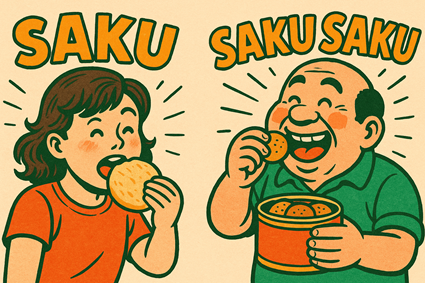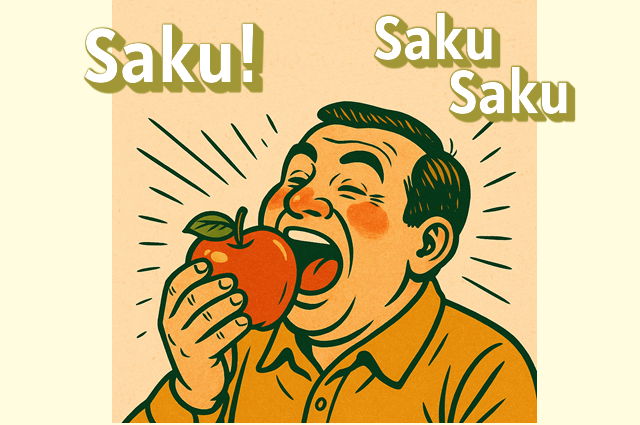Ever taken a crisp bite of a cookie that melts instantly?
Or munched through a crunchy snack that keeps going?
In Japanese, these nuances are expressed through onomatopoeia:
Saku (さく)
Saku Saku (さくさく)
What is “Saku” (さく)?
A momentary crispness or clean sharpness.
It’s the sound of that first bite — clear, light, and short.
Used for
- The clean snap of a rice cracker
- A dry leaf breaking
- A sharp cut or clean break
Nuance
- Instantaneous
- Precise, sharp, light
- A singular moment of crispness
Example:
She took a bite — and the crisp sound echoed:
saku!
Pronunciation
sah-koo
(short, crisp, and light)

What is “Saku Saku” (さくさく)?
A sound and feel of crispness, freshness, and effortless progress.
It’s that satisfying series of crunchy sounds as you keep munching.
Used for
- Crunching through cookies or tempura
- Walking briskly on snow or gravel
- Doing tasks smoothly and efficiently
Nuance
- Repetitive
- Light, pleasant
- Suggests ease or rhythm
Example:
She munched through the cookie with light, happy bites —
saku saku!
Pronunciation
sah-koo sah-koo
(bouncy, rhythmic, light)

Cultural Note
In English, you might use “crunch” or “crisp” for both.
But in Japanese:
- Saku = that first crisp bite
- Saku Saku = a series of pleasant crunches or even a feeling of light progress
That’s why in anime, you’ll hear saku saku for munching scenes or scenes of energetic movement — and saku for that satisfying first break or snap.
Examples in Daily Life

Example 1: Cookie bite (Saku)
She took a bite of the rice cracker —
saku!
Example 2: Crunchy cookie (Saku Saku)
He munched happily through the tin —
saku saku!
Try Using Them!
Cracking a leaf or cookie? → Say saku!
Crunching through a bag of snacks? → Say saku saku!
Working through your to-do list smoothly? → That’s saku saku too!












Comments